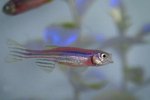About 2 percent of all bony fish species are hermaphrodites, having both male and female sex characteristics. The distinct reproductive advantage is that they can reproduce opposite-gender specimens are not in the pool. Two basic types of hermaphroditic fish exist: synchronous hermaphrodites and sequential hermaphrodites.
Why Change Sex?
Hermaphroditism is a reproductive strategy that is advantageous to some fish species. Fish who do not school, who live in deep or murky waters, or who have low population densities can have a hard time finding mates. Hermaphroditism enables a fish to change sex so it can mate with whatever individual of its own species it encounters.
Synchronous Hermaphrodites
Synchronous hermaphrodites are born with both ovaries and testes; both can produce eggs and sperm at maturity. Some species of salmon, sea bass and goby are synchronous hermaphrodites. These fish will form spawning pairs. One fish will lay eggs and the other will fertilize them. Then they switch roles and the second fish lays eggs so the first fish can fertilize them. The mangrove killifish is the only synchronous hermaphrodite known to self-fertilize, essentially cloning itself by fertilizing its eggs with its own sperm.
Sequential Hermaphrodites
Sequential hermaphrodites are born with dimorphic gonads, sex organs that have both male and female parts. At maturity, one part of the gonad is fully developed and the fish will either be male or female, capable of changing sex. There are two types of sequential hermaphrodites. Protogynous hermaphrodites are females that can change into males. Protandrous hermaphrodites are males that can change into females. Although most sequential hermaphrodites change sex only once if at all, during their lifetimes several species of goby can switch back and forth between sexes.
Protogynous Hermaphrodites
Most protogynous hermaphordites live in harems, with one male and a group of females. They reproduce by the male releasing his sperm into the water and all the females releasing their eggs. When the male dies, the dominant female becomes male. Some wrasses, parrotfish, and dwarf angelfish reproduce this way.
Protandrous Hermaphordites
Protandrous hermaphrodites are much less common than protogynous fish. Protandrous species include some clown fish, damselfish and black porgies. A breeding group of clown fish has one female, one male and several "neuters" who are sexually immature males. If the female dies, the male will change into a female and one of the neuters will develop into male.
References
Photo Credits
-
Comstock/Comstock/Getty Images
Writer Bio
Kimm Hunt has been writing professionally since 1990. She has written for businesses, government agencies and nonprofit organizations, and previously served as the editor of a weekly suburban Chicago newspaper. Hunt holds a B.S. in agriculture from the University of Illinois. She is also a professional dog trainer.





